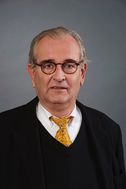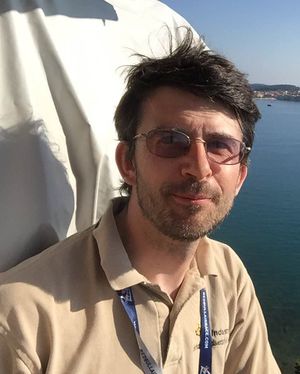| Line 11: | Line 11: | ||
* [[Plenary_speakers#speaker1| Tuesday, September 20: Rüdiger Dillmann (KIT Karlsruhe Institute of Technology, Karlsruhe, Germany)]] | * [[Plenary_speakers#speaker1| Tuesday, September 20: Rüdiger Dillmann (KIT Karlsruhe Institute of Technology, Karlsruhe, Germany)]] | ||
| − | * Wednesday, September 21: | + | * [[Plenary_speakers#speaker2| Wednesday, September 21: Simon J. Julier(University College London, United Kingdom)]] |
| Line 35: | Line 35: | ||
| − | [[File:dillmann.jpg| | + | [[File:dillmann.jpg|126px|frameless|left|Rüdiger Dillmann KIT Karlsruhe Institute of Technology, Karlsruhe, Germany|link=]] |
'''Rüdiger Dillmann''' received his Ph. D. from University of Karlsruhe in 1980. | '''Rüdiger Dillmann''' received his Ph. D. from University of Karlsruhe in 1980. | ||
| Line 50: | Line 50: | ||
| style="border:1px solid transparent;" |<br /> | | style="border:1px solid transparent;" |<br /> | ||
|- | |- | ||
| + | |||
| + | <!-- Speaker2 --> | ||
| + | {| id="mp-upper" style="width: 100%; margin:4px 0 0 0; background:none; border-spacing: 0px;" | ||
| + | <!-- Speaker2 --> | ||
| + | | class="MainPageBG" style="width:100%; border:1px solid #d6bdde; background:#f7eff7; vertical-align:top; color:#000;" | | ||
| + | {| id="mp-left" style="width:100%; vertical-align:top; background:#e7f7e76;" | ||
| + | | style="padding:2px;" | <h2 id="mp-tfa-h2" style="margin:4px; background:#e7deef; font-family:inherit; font-size:125%; font-weight:bold; border:1px solid #d6bdde; text-align:left; color:#000; padding:0.2em 0.4em;">Wednesday, September 21</h2> | ||
| + | |- | ||
| + | | style="color:#000;" | <div id="mp-tfa" style="padding:2px 5px"> | ||
| + | <div id="speaker2"> | ||
| + | === <div align="center">Simon J. Julier, University College London, United Kingdom</div> === | ||
| + | ==== <div align="center">Tractable Estimation in Nonlinear Systems</div> ==== | ||
| + | </div> | ||
| + | |||
| + | An awkward fact of life is that almost all systems of interest are nonlinear. Nonlinearities introduce many challenges for estimation systems, including biases, coupling through higher order dependencies, and restrict estimates to lie on nonlinear manifolds. Although these problems can be solved in theory, it is well-known that, in practice, the theoretical solutions are intractable and suboptimal approximations must be used. Historically, linear minimum mean squared error estimators such as the Kalman filter were developed. Given the limitations of these algorithms, many other approaches—such as particle filters, Gaussian mixture models, grids and kernel density estimators have been proposed. | ||
| + | |||
| + | In this talk, we revisit the problem of how to develop tractable methods which will improve the performance of least squares estimators in nonlinear systems. There are two reasons for this. First, some methods (such as mixture models) build upon linear estimators, and improving the performance of these improves the performance of the entire system. Second, approaches such as particle filters suffer from problems such as the curse of dimensionality, and cannot be applied in practice. In particular, this talk will review the sigma point approaches, such as the Unscented Kalman Filter (UKF), the Cubature Kalman Flter (CKF). We will show how these approaches lead to a framework which is naturally scalable. We will also discuss the strengths and limitations of these approaches. | ||
| + | |||
| + | |||
| + | [[File:julier.jpg|frameless|left|link=]] | ||
| + | |||
| + | '''Simon J. Julier''' is a Senior Lecturer at the Vision, Imaging and Virtual Environments Group, in the Computer Science Department at UCL. Before joining UCL, Dr. Julier worked for nine years at the 3D Mixed and Virtual Environments Laboratory at the Naval Research Laboratory in Washington DC. There he was PI of the Battlefield Augmented Reality System (BARS), a research effort to develop man-wearable systems for providing situation awareness information. He served as the Associate Director of the 3DMVEL from 2005–2006. His research interests include user interfaces, distributed data fusion, nonlinear estimation, and simultaneous localisation and mapping. | ||
| + | |- | ||
| + | |} | ||
| + | | style="border:1px solid transparent;" |<br /> | ||
| + | |- | ||
| + | |||
{{Organisation}} | {{Organisation}} | ||
__NOTOC____NOEDITSECTION__ | __NOTOC____NOEDITSECTION__ | ||
Revision as of 10:46, 14 September 2016
|
|
|



